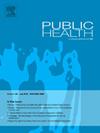屏幕时间与超重/肥胖之间的关系:来自36个低收入和中等收入国家的393,743名妇女的荟萃分析
IF 3.2
3区 医学
Q1 PUBLIC, ENVIRONMENTAL & OCCUPATIONAL HEALTH
引用次数: 0
摘要
全球超重和肥胖的流行率已经飙升,特别是在低收入和中等收入国家(LMICs),在这些国家,使用移动设备和看电视等久坐行为正变得越来越普遍。本研究探讨了这些行为与中低收入国家妇女超重/肥胖之间的关系。研究designMeta-analysis。方法采用2015年至2023年间通过人口与健康调查(DHS)收集的36个低收入国家393,743名妇女的数据进行荟萃分析。女性超重/肥胖状态定义为体重指数(BMI)为25 kg/m2或更高。统计分析包括单变量、双变量和随机效应荟萃分析,并通过亚组分析探讨区域差异。结果女性超重/肥胖总体患病率为30.1%。媒体使用频繁,60.8%的人使用手机,44.9%的人每周看电视,34.5%的人两者兼而有之。研究结果表明,手机使用与女性超重/肥胖之间存在显著的正相关,合并优势比(OR)为2.72 (95% CI: 2.37-3.12)。看电视也与女性超重/肥胖显著相关(OR = 1.95; 95% CI: 1.70-2.25)。同时使用移动设备和电视会进一步增加超重或肥胖的可能性(or = 2.41; 95% CI: 2.09-2.79)。亚组分析显示,非洲妇女尤其脆弱,与非非洲妇女相比,她们超重/肥胖的几率更高。结论:屏幕时间过长会增加中低收入国家妇女超重/肥胖的风险,尤其是在非洲。促进减少屏幕时间和积极生活方式的有文化针对性的政策对于培养更健康的习惯和减少相关的健康风险至关重要。本文章由计算机程序翻译,如有差异,请以英文原文为准。
Association between screen time and overweight/obesity: A meta-analysis of 393,743 women from 36 low- and middle-income countries
Objectives
The global prevalence of overweight and obesity has surged, particularly in low- and middle-income countries (LMICs), where sedentary behaviors such as mobile device use and television watching are becoming increasingly common. This study explores the relationship between these behaviors and overweight/obesity among women in LMICs.
Study design
Meta-analysis.
Methods
A meta-analysis was performed using data from 393,743 women across 36 LMICs, collected through the Demographic and Health Surveys (DHS) between 2015 and 2023. Women's overweight/obesity status was defined as a body mass index (BMI) of 25 kg/m2 or higher. Statistical analyses included univariate, bivariate, and random-effects meta-analyses, with subgroup analyses to explore regional variations.
Results
The overall prevalence of women with overweight/obesity was 30.1 %. Media use was frequent, with 60.8 % on mobile, 44.9 % watching television weekly, and 34.5 % doing both. The findings indicate a significant positive association between mobile use and women with overweight/obesity, with pooled odds ratio (OR) of 2.72 (95 % CI: 2.37–3.12). Television watching was also significantly associated with overweight/obesity of women (OR = 1.95; 95 % CI: 1.70–2.25). Combined exposure to both mobile devices and television further increased the likelihood of being overweight or obese (OR = 2.41; 95 % CI: 2.09–2.79). Subgroup analyses revealed that African women were particularly vulnerable, with higher odds of overweight/obesity compared to non-African women.
Conclusions
Excessive screen time increases the risk of overweight/obesity among women in LMICs, particularly in Africa. Culturally tailored policies promoting reduced screen time and active lifestyles are crucial for fostering healthier habits and reducing related health risks.
求助全文
通过发布文献求助,成功后即可免费获取论文全文。
去求助
来源期刊

Public Health
医学-公共卫生、环境卫生与职业卫生
CiteScore
7.60
自引率
0.00%
发文量
280
审稿时长
37 days
期刊介绍:
Public Health is an international, multidisciplinary peer-reviewed journal. It publishes original papers, reviews and short reports on all aspects of the science, philosophy, and practice of public health.
 求助内容:
求助内容: 应助结果提醒方式:
应助结果提醒方式:


